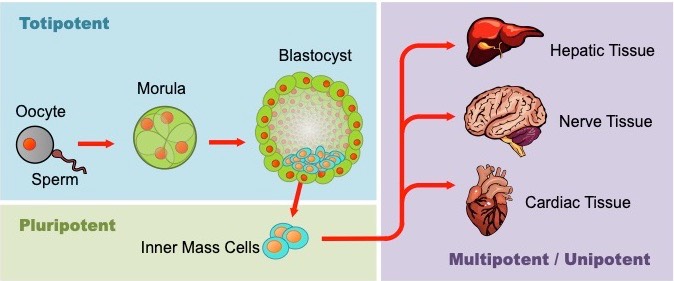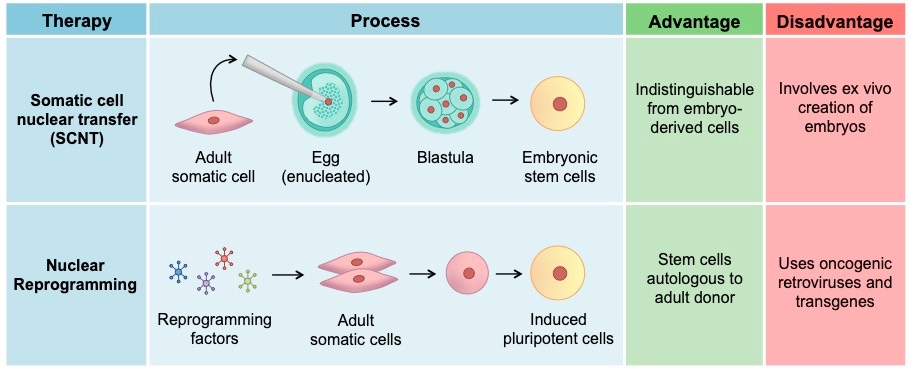Key Knowledge:
|
Differentiation is the process during development whereby newly formed cells become more specialised and distinct as they mature
- All cells of an organism share an identical genome – each cell contains the entire set of genetic instructions for that organism
- The activation of different instructions (genes) within a given cell (triggered by chemical signals) will cause the cell to differentiate

Stem Cells
When a cell differentiates and becomes specialised, it typically loses its capacity to form alternative cell types
- This is why organs and limbs cannot be regenerated following trauma of the occurrence of particular diseases
Stem cells are unspecialised cells that have two key qualities:
- Self-renewal – They can continually divide and replicate to repopulate a entire cell line
- Potency – They have the capacity to differentiate into different cell types (they are unspecialised)
There are four main types of stem cells present at various stages of human development:
- Totipotent – Can form any cell type, as well as extra-embryonic (placental) tissue (i.e. can give rise to new organisms)
- Pluripotent – Can form any cell type (e.g. embryonic stem cells that are responsible for gastrulation)
- Multipotent – Can differentiate into a number of closely related cell types (e.g. haematopoeitic adult stem cells)
- Unipotent – Cannot differentiate, but are capable of self renewal (e.g. progenitor cells, muscle stem cells)

Stem Cell Therapy
Stem cells can be used to replace damaged or diseased cells with healthy, functioning ones
This process requires:
- The use of biochemical solutions to trigger the differentiation of stem cells into the desired cell type
- Surgical implantation of cells into the patient’s own tissue
- Suppression of host immune system to prevent rejection of cells (if stem cells are from foreign source)
- Careful monitoring of new cells to ensure they do not become cancerous
Stem cells can potentially be used to treat a wide variety of disease conditions, including:
- Macular degeneration: Replacing dead cells in the retina with functioning new ones to limit the onset of blindness
- Parkinson’s disease: Regenerate dopamine-producing neurons within the midbrain to improve general mobility
- Leukemia: Bone marrow transplants for cancer patients who are immunocompromised as a result of chemotherapy
- Paraplegia: Repair damage caused by spinal injuries to enable paralysed victims to regain movement
- Diabetes: Replace non-functioning islet cells with those capable of producing insulin in type I diabetics
- Burn victims: Graft new skin cells to replace damaged tissue

Ethics of Stem Cell Therapy
Pluripotent (embryonic) stem cells are not present within adult tissue, restricting the viability and potential of stem cell therapy
- Adult stem cells can be used, but as they are only multipotent they will only be viable as a therapy for certain specific diseases
The ethical considerations associated with the therapeutic use of stem cells will depend on the source
- Using multipotent adult tissue involves fewer ethical consideration, but can only be used in specific circumstances (less scope)
- Stem cells derived from umbilical cord blood will need to be stored and preserved at cost, raising issues of availability and access
- The greatest yield of pluripotent stem cells comes from embryos, but requires the destruction of a potential living organism
Stem cells can be artificially generated via nuclear transfer or nuclear reprogramming, with distinct benefits and disadvantages
- The main benefit is the stem cells created will be a genetic match to the donor, which lowers the possibility of graft rejection
Somatic Cell Nuclear Transfer
- Somatic cell nuclear transfer (SCNT) creates embryonic clones by fusing a diploid nucleus with an enucleated egg cell
- More embryos are created by this process than needed, raising ethical concerns about the exigency of excess embryos
Nuclear Reprogramming
- Nuclear reprogramming induce a change in the gene expression profile of a cell in order to transform it into a different cell type
- This transdifferention process involves using oncogenic retroviruses and transgenes, increasing the risk of health consequences
